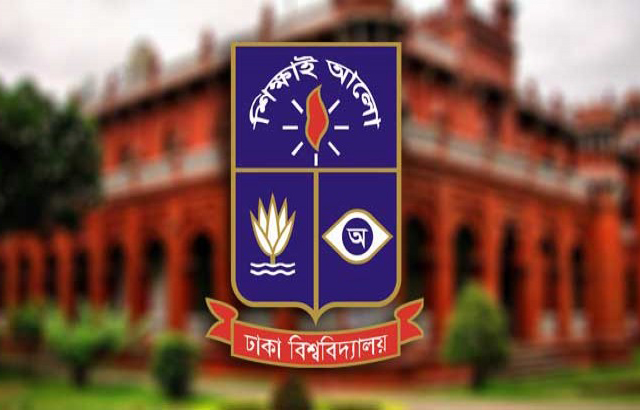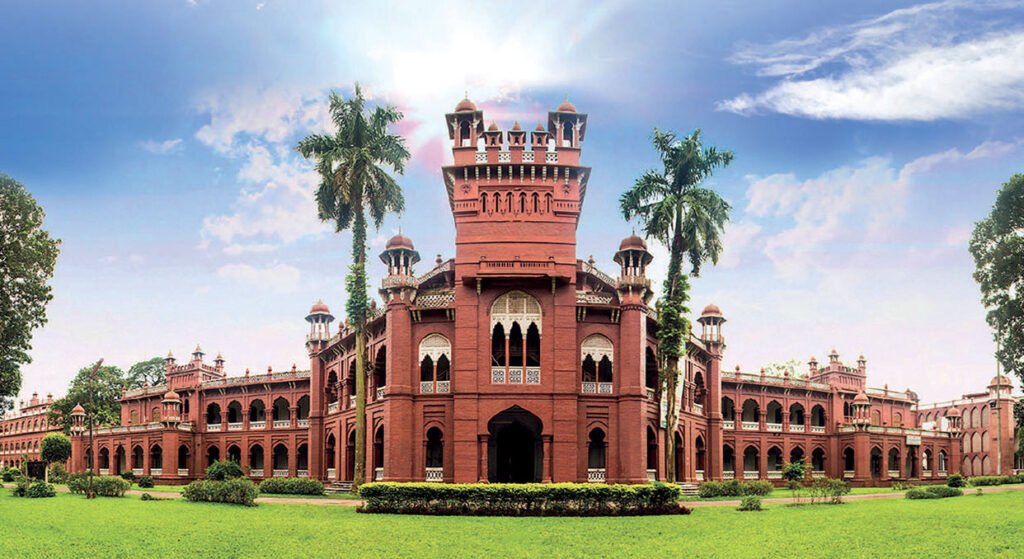Introduction

The University of Dhaka (DU), also known as Dhaka University, is the premier institution of higher education in Bangladesh. Established in 1921, it has played a significant role in shaping the country’s academic, political, and cultural landscape. Often referred to as the “Oxford of the East,” Dhaka University has been a center of excellence in research, education, and national movements. This essay provides an in-depth exploration of Dhaka University, covering its history, academic programs, contributions, challenges, and future prospects.
1. History and Establishment of Dhaka University
1.1 Colonial Background and Need for a University
During the British colonial period, Bengal was a major intellectual hub of India. After the partition of Bengal in 1905 (which was annulled in 1911), the demand for an advanced educational institution in East Bengal grew stronger. Muslim intellectuals and leaders, including Nawab Sir Khwaja Salimullah and Chittaranjan Das, advocated for the establishment of a university in Dhaka to cater to the needs of Bengali Muslims, who were educationally lagging behind Hindus.
1.2 Formation and Official Inauguration
The University of Dhaka was established on 1st July 1921 under the Dacca University Act of 1920, passed by the British government. The university started with three faculties:
- Faculty of Arts
- Faculty of Science
- Faculty of Law
At its inception, there were 877 students and 60 teachers. The first Vice-Chancellor was Dr. Philip Joseph Hartog, a distinguished British academic. DU initially followed the Oxford-Cambridge model of residential education.
1.3 Role in Political Movements
Dhaka University has been central to major political and social movements in Bangladesh, including:
- The Language Movement (1952): DU students, including Salam, Rafiq, Barkat, and Jabbar, were martyred while protesting for Bangla to be recognized as a state language.
- The Mass Uprising of 1969: DU students played a crucial role in mobilizing protests against the Pakistani government, which eventually led to the fall of Ayub Khan.
- The Liberation War (1971): Many teachers, students, and staff of DU were massacred by the Pakistani army during Operation Searchlight on March 25, 1971.
- The Anti-Autocracy Movement (1990): DU students and faculty played a key role in the downfall of military dictator General Ershad.
2. Campus and Infrastructure
2.1 Location and Campus Layout
Dhaka University is located in Shahbagh, Dhaka, covering an area of 600 acres. The campus is divided into multiple zones, including:
- Academic Zone: Consisting of faculties, departments, and research centers.
- Residential Zone: Student dormitories and faculty housing.
- Administrative Zone: Offices of the Vice-Chancellor, Pro-Vice-Chancellors, and Registrar.
- Sports and Recreation: Gymnasium, playgrounds, and the Teacher-Student Center (TSC).
2.2 Notable Buildings and Monuments

- Curzon Hall: Historic science faculty building, named after Lord Curzon.
- Aparajeyo Bangla: Iconic sculpture symbolizing the Liberation War.
- Central Library: One of the largest libraries in Bangladesh, with over 700,000 books.
- Shahid Minar: Memorial for the Language Movement martyrs.
- TSC (Teacher-Student Center): A hub for student activities and cultural events.
3. Academic Structure
3.1 Faculties and Departments
Dhaka University currently has 13 faculties and 83 departments, covering a wide range of disciplines. The major faculties include:

A. Faculty of Arts
- Bangla
- English
- History
- Philosophy
- International Relations
B. Faculty of Science
- Physics
- Chemistry
- Mathematics
- Statistics
- Biotechnology
C. Faculty of Business Studies
- Finance
- Marketing
- Accounting
- Banking & Insurance
D. Faculty of Social Sciences
- Economics
- Political Science
- Sociology
- Public Administration
E. Faculty of Engineering & Technology
- Electrical and Electronic Engineering
- Robotics & Mechatronics Engineering
- Computer Science and Engineering
In addition, Dhaka University has professional institutes such as the Institute of Business Administration (IBA), Institute of Education and Research (IER), and Institute of Modern Languages (IML).
3.2 Research and Innovation
Dhaka University has a strong research culture. Some notable research centers include:
- Center for Advanced Research in Science (CARS)
- Biotechnology Research Center
- Economics Research Bureau
Many DU scholars contribute to international journals, and DU researchers have played a key role in fields like climate change, biotechnology, and social sciences.
4. Student Life and Extracurricular Activities
4.1 Residential Halls
Dhaka University has 23 residential halls, including:
- Jagannath Hall: The only dormitory for Hindu students.
- Sufia Kamal Hall: A hall for female students.
- Salimullah Muslim Hall: One of the oldest halls.
4.2 Cultural and Student Organizations
- DUCSU (Dhaka University Central Students’ Union): The central body of student governance.
- Dhaka University Debating Society (DUDS): One of the most prestigious debating platforms.
- Dhaka University Film Society (DUFS): Organizes film festivals and cultural activities.
- Various political and social organizations: Including student wings of political parties.
4.3 Annual Events
- Pohela Boishakh (Bengali New Year) celebrations at TSC.
- February 21st Language Martyrs’ Day: Observed at Shaheed Minar.
- Convocation ceremonies: Where degrees are awarded.
5. Challenges and Future Prospects
5.1 Challenges
Despite its prestigious status, Dhaka University faces several challenges:
- Political Influence: Student politics often leads to violence and disruptions.
- Resource Constraints: Overcrowding, lack of modern facilities, and insufficient research funding.
- Faculty Shortages: Many departments suffer from a lack of qualified teachers.
- Unemployment Issues: Many graduates struggle to find employment due to skill mismatches.
5.2 Future Prospects and Reforms
To maintain its excellence, DU needs:
- Increased funding for research and infrastructure.
- A more transparent recruitment system to attract global talent.
- Strengthening industry-academia partnerships to improve employability.
- Greater digitization and introduction of smart classrooms.
Conclusion
Dhaka University has been an integral part of Bangladesh’s history, culture, and education. It has produced some of the nation’s greatest leaders, scholars, and activists. Despite facing challenges, DU remains the most prestigious institution in Bangladesh. With the right policies and reforms, it has the potential to become a world-class university, continuing its legacy as a center of knowledge and social progress.
Word Count: ~2500 words